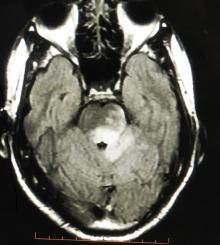当前位置:
X-MOL 学术
›
J. Neuroimmunol.
›
论文详情
Our official English website, www.x-mol.net, welcomes your
feedback! (Note: you will need to create a separate account there.)
Isolated opsoclonus heralding neuromyelitis optica spectrum disorder
Journal of Neuroimmunology ( IF 2.9 ) Pub Date : 2020-11-01 , DOI: 10.1016/j.jneuroim.2020.577394 Ritwik Ghosh 1 , Souvik Dubey 2 , Biman Kanti Ray 2 , Siktha Purkait 1 , Alak Pandit 2 , Julián Benito-León 3
Journal of Neuroimmunology ( IF 2.9 ) Pub Date : 2020-11-01 , DOI: 10.1016/j.jneuroim.2020.577394 Ritwik Ghosh 1 , Souvik Dubey 2 , Biman Kanti Ray 2 , Siktha Purkait 1 , Alak Pandit 2 , Julián Benito-León 3
Affiliation

|
Opsoclonus is an ocular motility disorder characterized by spontaneous, arrhythmic conjugate saccades of varying amplitude occurring in all directions of gaze without normal intersaccadic interval. Etiological spectrum of opsoclonus encompasses paraneoplastic and neoplastic conditions, infectious and para-infectious encephalitis, autoimmune, metabolic and toxic encephalopathies, drugs, motor neuron diseases, multiple sclerosis and rarely neuromyelitis optica spectrum disorder (NMOSD). Opsoclonus has never been reported as a presenting manifestation heralding NMOSD. We herein report a previously healthy 37-year-old Asian Indian woman who presented with oscillopsia and opsoclonus, followed, 12 h later, by right-sided hemiparesis, right-sided appendicular ataxia, and left-sided lower motor neuron type facial palsy and dysarthria. Brain magnetic resonance imaging revealed hyperintense lesions in brainstem and thalamus in T2-weighted and fluid attenuated inversion recovery-weighted images, quite suggestive of NMOSD. Serum and cerebrospinal fluid samples were positive for anti-aquaporin-4 antibodies, which clinched the diagnosis of seropositive NMOSD. After completion of a course of intravenous methylprednisolone 1 g/day for 5 days, her opsoclonus disappeared completely. There was significant improvement in her speech and weakness within the first week of therapy and no objective deficit after day 20 of admission. After one-and-a-half-year follow-up, the patient was maintaining well on rituximab as secondary prophylaxis without any further attack. Our case highlights that isolated opsoclonus can be the presenting feature of NMOSD.
中文翻译:

孤立的视阵挛预示视神经脊髓炎谱系障碍
Opsoclonus 是一种眼球运动障碍,其特征是在所有注视方向发生不同幅度的自发性、心律失常共轭跳视,而没有正常的跳视间隔。Opsoclonus 的病因谱包括副肿瘤和肿瘤疾病、感染性和副感染性脑炎、自身免疫性、代谢性和毒性脑病、药物、运动神经元疾病、多发性硬化症和罕见的视神经脊髓炎谱系障碍 (NMOSD)。Opsoclonus 从未被报告为预示 NMOSD 的表现。我们在此报告了一名既往健康的 37 岁亚裔印度女性,她出现摆动视和眼阵挛,12 小时后出现右侧偏瘫、右侧四肢共济失调和左侧下运动神经元型面瘫和构音障碍。脑磁共振成像显示 T2 加权和液体衰减反转恢复加权图像中脑干和丘脑的高信号病变,非常提示 NMOSD。血清和脑脊液样本的抗水通道蛋白 4 抗体呈阳性,这确定了血清阳性 NMOSD 的诊断。在完成静脉甲泼尼龙 1 g/天 5 天的疗程后,她的眼阵挛完全消失。在治疗的第一周内,她的言语和虚弱有显着改善,入院 20 天后没有客观缺陷。经过一年半的随访,患者在使用利妥昔单抗作为二级预防的情况下保持良好状态,没有进一步发作。我们的案例强调孤立的视阵挛可能是 NMOSD 的表现特征。
更新日期:2020-11-01
中文翻译:

孤立的视阵挛预示视神经脊髓炎谱系障碍
Opsoclonus 是一种眼球运动障碍,其特征是在所有注视方向发生不同幅度的自发性、心律失常共轭跳视,而没有正常的跳视间隔。Opsoclonus 的病因谱包括副肿瘤和肿瘤疾病、感染性和副感染性脑炎、自身免疫性、代谢性和毒性脑病、药物、运动神经元疾病、多发性硬化症和罕见的视神经脊髓炎谱系障碍 (NMOSD)。Opsoclonus 从未被报告为预示 NMOSD 的表现。我们在此报告了一名既往健康的 37 岁亚裔印度女性,她出现摆动视和眼阵挛,12 小时后出现右侧偏瘫、右侧四肢共济失调和左侧下运动神经元型面瘫和构音障碍。脑磁共振成像显示 T2 加权和液体衰减反转恢复加权图像中脑干和丘脑的高信号病变,非常提示 NMOSD。血清和脑脊液样本的抗水通道蛋白 4 抗体呈阳性,这确定了血清阳性 NMOSD 的诊断。在完成静脉甲泼尼龙 1 g/天 5 天的疗程后,她的眼阵挛完全消失。在治疗的第一周内,她的言语和虚弱有显着改善,入院 20 天后没有客观缺陷。经过一年半的随访,患者在使用利妥昔单抗作为二级预防的情况下保持良好状态,没有进一步发作。我们的案例强调孤立的视阵挛可能是 NMOSD 的表现特征。











































 京公网安备 11010802027423号
京公网安备 11010802027423号